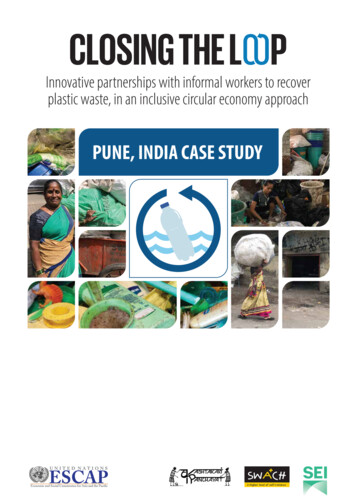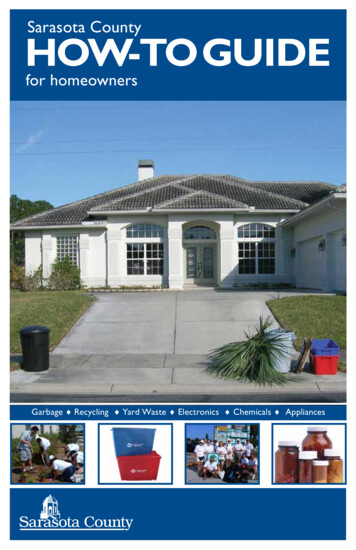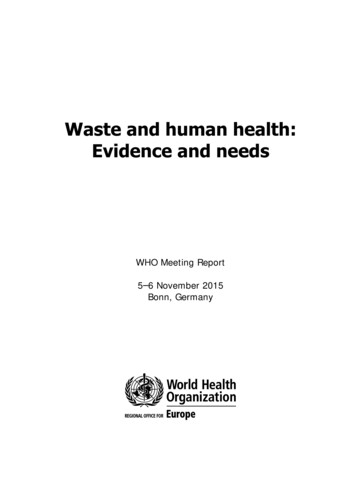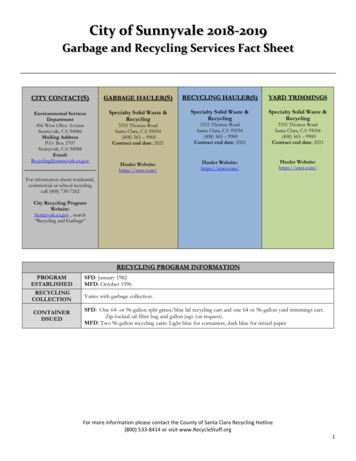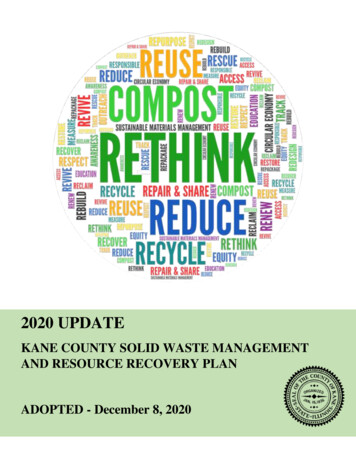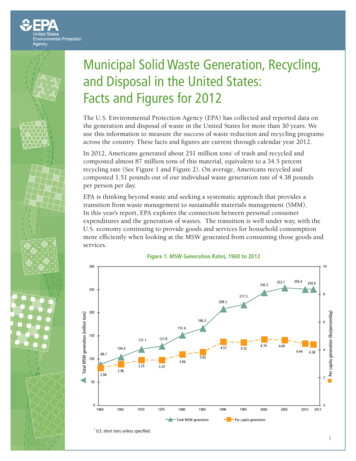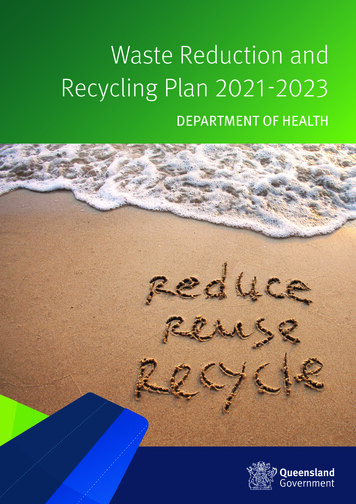
Transcription
Waste Reduction andRecycling Plan 2021-2023DEPARTMENT OF HEALTH
Waste Reduction and Recycling Plan 2021-2023 Department of HealthPublished by the State of Queensland(Queensland Health), February 2021This document is licensed under a Creative CommonsAttribution 3.0 Australia licence.To view a copy of this licence, visitcreativecommons.org/licenses/by/3.0/au State of Queensland (Queensland Health) 2021You are free to copy, communicate and adaptthe work, as long as you attribute the State ofQueensland (Queensland Health).For more information contact:Sustainable Operations Unit, Queensland Health,GPO Box 48, Brisbane QLD 4001,sustainableoperations@health.qld.gov.auWaste Reduction and Recycling Plan Queensland HealthDepartment of Health Waste Reduction and Recycling Plan 2021-2023ii
TABLE OF CONTENTS1.0 Introduction.1Scope. 2Queensland government waste and recycling priorities and targets. 32.0 Organisational overview.2Departmental waste profile. 2Commitment to continuous improvement. 33.0 Guiding frameworks.6Waste and resource management hierarchy. 6Waste and resource management principles. 64.0 Objectives and strategies.125.0 Monitoring, reporting and review.13
1IntroductionThe Waste Reduction and Recycling Act 2011 requires the Department of Health (theDepartment) to prepare, adopt and implement a waste reduction and recycling plan.This Department of Health Waste Reduction and RecyclingPlan 2021-2023 sets the direction for waste managementwithin the Department for the next three years and replacesthe previous 2018-2020 Plan.The Department is committed to ensuring that its wastemanagement practices contribute to the delivery andachievement of the Queensland Government’s statewidewaste reduction, diversion and recycling actions andtargets.SCOPEThe Department of Health Waste Reduction and RecyclingPlan 2021-2023 applies to all divisions of the Department(including the Queensland Ambulance Service).The plan does not cover Hospital and Health Services orlaboratories operated by the Department that generalclinical waste as they are covered by separate wastereduction and recycling plans.high-level plan for a better way of managing waste inQueensland, by harnessing the potential value of resourcesthat would have previously been sent to landfill. Thestrategy has three strategic priorities to support thetransition to a zero-waste society:»reducing the impact of waste on the environment»transitioning to a circular economy for waste»building economic opportunity.Transitioning to a circular economy represents a systemicshift that builds long-term resilience, generates businessand economic opportunities, and provides environmentaland societal benefits.RAWMATERIALSRESIDUALWASTEQUEENSLAND GOVERNMENTWASTE AND RECYCLINGPRIORITIES AND TARGETSRecyclingDesignThe Queensland Government’s vision is for Queenslandto become a zero-waste society, where waste is avoided,reused and recycled to the greatest possible extent; andstrategic investment in diverse and innovative resourcerecovery technology and markets will produce high-valueproducts and generate economic benefits for the state.CollectionCIRCULARECONOMYThe Government is progressing this vision through theQueensland Waste Management and Resource RecoveryStrategy (the Strategy), and associated Resource RecoveryIndustry Development Program and Resource RecoveryIndustries 10-year Roadmap. The strategy presents aProduction &RemanufacturingConsumption, use,resuse & repairDistributionDepartment of Health Waste Reduction and Recycling Plan 2021-20231
The Government has set long-term and interim wastereduction, diversion and recycling targets to support thestrategy’s vision, drive market growth and deliver thebenefits associated with improved waste management.LONG-TERM TARGETS FOR THE YEAR 205025%reduction in householdwaste90%of waste is recovered anddoes not go to landfill75%recycling rates acrossall waste typesINTERIM TARGETS FOR THE YEARS 2025, 2030 AND 2040Interim targets have been set for waste reduction, waste diversion and recycling for specific streams: municipal solid waste(MSW), commercial and industrial waste (C&I) and construction and demolition (C&D).WASTE REDUCTION TARGETS FOR HOUSEHOLDS (PER CAPITA)STREAMBASELINE (2018)202520302040MSW0.54T10%15%20%WASTE DIVERSION FROM LANDFILL TARGETS (RECOVERY RATE AS PERCENTAGE OF TOTAL WASTE GENERATED)STREAMBASELINE 0%C&D50.9%75%85%85%OVERALL45.4%65%80%85%RECYCLING RATES (AS PERCENTAGE OF TOTAL WASTE GENERATED)STREAMBASELINE 5%C&D50.9%75%80% 80%OVERALL44.9%60%65%70%Department of Health Waste Reduction and Recycling Plan 2021-20232
In addition to the strategy, the Government hasimplemented a number of initiatives to reduce wastegeneration, increase resource recovery and eliminatelittering including:»a ban on the supply of single-use lightweight plasticshopping bags and introduction of a Container RefundScheme to improve recycling of beverage containers»a waste levy to encourage waste avoidance and reducethe amount of waste going to landfill and also providea source of funding to enable better resource recoverypractices»amount of plastic in the environment.The actions most relevant to theDepartment of Health’s operations include:the development of the Litter and Illegal Dumping: A Planfor Queensland and the Plastic Pollution Reduction Plan.Aligned to the strategy, the Plastic Pollution Reduction Planidentifies and prioritises 18 actions across the plasticssupply chain to reduce plastic waste and ultimately, the»Using government purchasing power to reduceplastic use, require recycled plastic content, andtransform the supply market by identifying thereduction of plastic pollution as a government prioritythrough the Queensland procurement policy»Applying the power in the Waste Reduction and RecyclingAct 2011 to have the ‘product stewardship’ principleapplied to oxo-degradable plastics and polyvinyl chloride(PVC), thereby ensuring shared responsibility betweenall involved in the lifecycle of these plastics for managingtheir environmental, social and economic impacts.Department of Health Waste Reduction and Recycling Plan 2021-20233
2OrganisationaloverviewThe Department provides strategicleadership and direction to the publichealth system in Queensland as well aspromoting and protecting the health ofQueenslanders through health promotioncampaigns and other disease preventionactivities.The Department’s responsibilities include:»providing strategic leadership and direction for healththrough development and administration of policies andlegislation»developing statewide plans for health services, workforceand major capital investment»managing major capital works for public sector healthservice facilities»purchasing health services»supporting and monitoring the quality, efficiency,effectiveness and timeliness of health service delivery»delivering a range of specialised services, includingprevention, promotion and protection, providingambulance, aeromedical, health information andcommunication technology; and statewide health supportservices such as biomedical and technical services,forensic and scientific services, pathology, centralpharmacy, linen, strategic procurement and centralisedwarehousing and logistics operations.To ensure Queenslanders receive the best possible care,the Department enters into a service agreement with eachHospital and Health Service to deliver public health servicesin their local area.The Department includes 10 operational divisions that workdirectly with Hospital and Health Services, stakeholdersand governments. The Department operates under a varietyof accommodation arrangements throughout Queensland.These may include being the sole tenant, or one of manytenants in a Department-owned, government-owned orprivately leased building or facility. The type of tenancyarrangement significantly impacts the extent to which theDepartment can directly influence, or implement change to,waste management operations (including data collection) inbuildings or facilities it occupies.DEPARTMENTAL WASTE PROFILEAs a waste generator, the Department is committed toensuring that available resources are used efficiently andeffectively for future generations, and to minimise waste inthe delivery of its services.For the purpose of waste management, the Department’soperations are divided into two broad categories: officebased and non-office based. The rationale behind thisdistinction is the underlying assumption that office-basedfunctions will generate a generic waste stream irrespectiveof the geographical location or the specific role performed.The waste generated by the Department’s office-basedoperations includes general solid waste, co-mingledDepartment of Health Waste Reduction and Recycling Plan 2021-20234
recycling (e.g. plastic drink bottles, food containers,aluminium cans), paper (including cardboard), organicwaste (e.g. food scraps), and electronic waste such ascomputers and photocopiers and associated consumables(e.g. toner cartridges).Non-office-based operations include some support servicesprovided to Hospital and Health Services such as biomedicaltechnology; clinical and forensic pathology; logistics,warehousing and laundry; and ambulance services. Thewaste generated by the Department’s non-office-basedoperations includes:»liquid waste»pharmaceutical waste (e.g. expired medicines) and wastegenerated from the use of raw materials in pharmaceuticalmanufacturing processes»non-clinical waste generated from laboratories eitherembedded in Hospital and Health Services or onDepartment-owned sites including Forensic and ScientificServices at Coopers Plains»waste (under the Department’s operational control)associated with supply logistics and vehicle fleetmanagement (e.g. tyres, oil, transportation and storageequipment)»general solid waste, co-mingled recycling, paper (includingcardboard) and organic waste, and electronic waste.The construction, renovation and maintenance work forthe Department’s tenanted buildings is usually undertakenby third parties (e.g. external contractors) on behalf of thebuilding owner, the Department and agencies. In theseinstances, the Department is not directly responsible for theassociated waste generated from these operations, but maybe able to influence waste minimisation activities, such asby encouraging contractors to divert as much waste awayfrom landfill through the effective use, reuse and recyclingof materials. The Department can also influence thecontractor in undertaking and reporting waste reuse and/orrecycling for works undertaken in its owned buildings.The Department is also not directly responsible for wastegenerated by Hospital and Health Services. However, thereare opportunities for the Department (in its role as systemmanager) to improve waste reporting capability acrossQueensland Health; and, through its strategic procurementfunction, to support Hospital and Health Services to reducetheir waste generation and increase their recycling andrecovery activity. This has become particularly importantgiven the increased usage of single-use personal protectiveequipment items as a result of COVID-19 requirements; andthe Queensland Government’s commitment to reducingplastic pollution.Department of Health Waste Reduction and Recycling Plan 2021-20235
COMMITMENT TO CONTINUOUS IMPROVEMENTBelow are some examples of initiatives introduced to datedemonstrating the Department’s commitment to continuousimprovement and its progress towards a responsible andsustainable waste management system.»Avoid resource consumption or reduce waste generationTrialling and supporting tenant/staff led recyclingactivities:»Mobile phones»Batteries»Disposable coffee cups and lids (Simply Cups)»Setting printers to double-sided and black and whiteprinting as a default»aluminium, glass, plastic, steel and liquid paperboardbeverage containers (Containers for Change)»Removal of individual desk-side waste bins.»Plastic bottle tops»Reuse waste resources»Health Technology Equipment Replacement DisposalProgram – facilitating the sale of health technologyequipment that has reached the end of useful life»‘The Market Place’ – facilitating the re-use of unwanted orsurplus office consumables at the Department’s CharlotteStreet and Butterfield Street offices»ICT equipment disposal program – facilitating the re-useof electronic assets.Recycle waste»Introducing ‘EcoBins’ to enable employees to separatewaste in their workplaces»Separation and re-cycling of co-mingled waste»Recycling of cardboard and paper, and printer cartridges»ICT disposal program – facilitating the recycling ofelectronic waste.Improving recycling rates, where possible, by optimisingwaste management contracts and working with waste andcleaning contractors.The Department’s 2018-2020 plan identified the importanceof collecting reliable baseline data, in order to understandthe types and quantities of waste generated from itsoperations, thereby enabling it to focus on activities thatwill realise the greatest benefit. However, the collectionof reliable and comparable baseline data to accuratelyidentify and quantify the volume of the Department’s wastegeneration and recycling remains challenging. This has beenpredominantly due to third party arrangements and leasingcontracts; and a lack of a state-wide system to manage andcontrol waste streams, waste generation, waste reductionand cost. Improving data integrity, capture and utilisationwill be a key focus for improvement going forward.Department of Health Waste Reduction and Recycling Plan 2021-20236
3Guiding frameworksThe Waste Reduction and Recycling Act2011 requires the Department’s wastereduction and recycling plan to haveregard to:» the waste and resource managementhierarchy» waste and resource managementprinciples.WASTE AND RESOURCEMANAGEMENT HIERARCHYThe waste and resource management hierarchy (Figure1), sets an order of preference for options to managewaste, from avoiding and reducing (most preferred), tore-using, recycling, recovering, treating and disposal (leastpreferred).The hierarchy is a tool to help decision-makers prioritisewaste reduction and recycling activities. Where avoidance orreduction is not possible, options should be investigated forthe re-use and then recycling of waste materials. As a nextavailable option, waste could be used as a source of energy.Disposal of waste to landfill should be considered only as alast resort.INTEGRATED WASTE MANAGEMENTTHE WASTE AND RESOURCE MANAGEMENT HIERARCHYPrevent/ReduceSOURCE REDUCTIONReuseWASTE DIVERSIONRecycleRecoverRESIDUAL WASTEMANAGEMENTDisposeDepartment of Health Waste Reduction and Recycling Plan 2021-20237
WASTE AND RESOURCE MANAGEMENT PRINCIPLESThe waste and resource management principles applicable under the Waste Reductionand Recycling Act 2011 are the ‘polluter pays principle’, the ‘proximity principle’ and the‘product stewardship’ principle.THE ‘POLLUTER PAYS PRINCIPLE’The ‘polluter pays principle’ states that all costs associated with the management of waste should be borneby the persons who generated the waste. The costs associated with the management of waste may includethe costs of minimising the amount of waste generated; containing, treating and disposing of waste; andrectifying environmental harm caused by waste.THE ‘PROXIMITY PRINCIPLE’The ‘proximity principle’ states that waste and recovered resources should be managed as close to thesource of generation as possible.THE ‘PRODUCT STEWARDSHIP PRINCIPLE’The ‘product stewardship principle’ states that there is a shared responsibility between all persons who areinvolved in the lifecycle of a product for managing the environmental, social and economic impact of theproduct.Department of Health Waste Reduction and Recycling Plan 2021-20238
4Objectives andstrategiesThe Department is committed tocontinuous improvement in themanagement of its waste. Over the period2021-2023, the Department will focus onactions to:contribute to the achievement of the QueenslandGovernment’s statewide waste reduction and recyclingpriorities and targets»strengthen and optimise its waste management practices,including waste avoidance, recycling, and resourcerecovery»drive change through its strategic procurement andfacilities management functions»improve data integrity and utilisation and wastemanagement knowledge across Queensland Health»where possible, improve the consistency of wastereduction and recycling activities across facilities leasedby the DepartmentOBJECTIVE»strengthen engagement withstakeholders»through its role as systemleader, support Hospitaland Health Services to worktowards a circular economy deliveringimproved environmental and human health outcomesfrom waste minimisation, recovery and recyclingactivities.Actions taken by the Department under this plan willbe implemented under a framework of three strategicobjectives and nine key strategies. Strategic objectives1 and 2 align directly with the Queensland WasteManagement and Resource Recovery Strategy.A detailed action plan will be developed in early 2021that maps deliverables, performance targets/measures,milestones and responsibilities against the objectives andstrategies. The action plan will be reviewed on an ongoingbasis and updated as required in response to emergingpriorities and opportunities, or operational changes.123REDUCE THE IMPACT OF WASTEON THE ENVIRONMENTTRANSITION TO A CIRCULARECONOMY FOR WASTEDRIVE CONTINUOUSIMPROVEMENT THROUGH DATAAND ENGAGEMENT1.1 Support the implementation ofQueensland Government wastemanagement and recyclinglegislation, policies andstrategies.STRATEGIES»1.2 Leverage procurement contractsand lease arrangements to drivechange.1.3 Investigate an integratedapproach to energy, wasteand water to influence thesustainability of QueenslandHealth assets and facilities.2.1 Maximise the reduction, re-use,repurposing, recycling andrecovery of waste generatedby the Department and, wherepossible, Hospital and HealthServices.2.2 Create systematic change toincentivise circularity at theDepartment through innovation,resilience and operationalchange where possible.3.1 Strengthen data integrity,capture and utilisation acrossQueensland Health.3.2 Strengthen statewidepartnerships within QueenslandHealth to improve wastemanagement and knowledge andpractice across the system.3.3 Engage with key externalstakeholders to gain insights andidentify innovations and bestpractice.3.4 Raise employee awarenessof good waste managementpractices.Department of Health Waste Reduction and Recycling Plan 2021-20239
5Monitoring,reporting and reviewThe Sustainable Operations Unit within the Capital and Asset Services Branch ofCorporate Services Division will be responsible for proactively managing and monitoringthe Department’s obligations under the Waste Reduction and Recycling Act 2011 withrespect to this plan.In line with its obligations under the Act the Department will review this plan at least every three years as a minimum and reportto the Department of Environment and Science on the status of the plan within two months after the end of each financial year.The plan may also be amended or updated within the three-year period if required.
associated with supply logistics and vehicle fleet management (e.g. tyres, oil, transportation and storage equipment) » general solid waste, co-mingled recycling, paper (including cardboard) and organic waste, and electronic waste. The construction, renovation and maintenance work for the Department's tenanted buildings is usually undertaken

